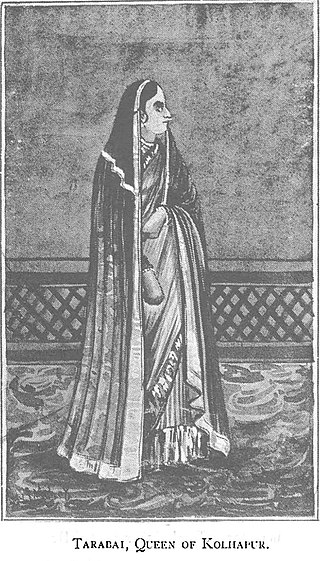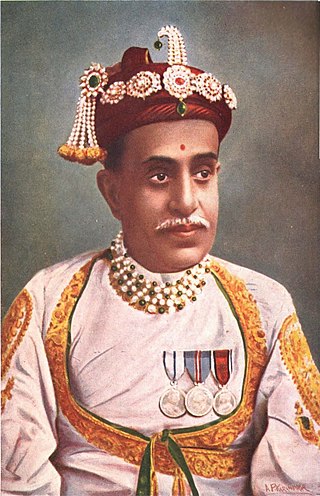
Bajirao I, born as Visaji, was the 7th Peshwa of the Maratha Confederacy. During his 20-year tenure as a Peshwa, he defeated the Nizam of Hyderabad at several battles like the Battle of Palkhed and Battle of Bhopal. Bajirao contributed to Maratha supremacy in Southern India and Northern India. Thus, he was responsible for establishing Maratha power in Gujarat, Malwa, Rajputana and Bundelkhand and liberating Konkan from the Siddis of Janjira and Portuguese rule. He is considered one of the greatest cavalry generals of India.

The Maratha Empire, also referred to as the Maratha Confederacy, was an early modern Indian empire and later a confederation that controlled large portions of the Indian subcontinent in the 18th century. Maratha rule formally began in 1674 with the coronation of Shivaji of the Bhonsle dynasty as the Chhatrapati. Although Shivaji came from the Maratha caste, the Maratha empire also included warriors, administrators and other nobles from the Maratha and several other castes from what is known today as Maharashtra.

The Peshwa was second highest office in the Maratha Confederacy, next in rank and prestige only to that of the Chhatrapati. Initially serving as the appointed prime minister in the Maratha empire, the office became hereditary after the death of Shahu in 1749. During the reign of Shahu, the office of Peshwa became incredibly powerful and the Peshwas came to be the de facto rulers of the Maratha empire. However following the defeat of the Marathas in 1761, the office of the Peshwa became titular as well and from that point onwards served as the ceremonial head of the Confederacy underneath the Chhatrapati.

Balaji Vishwanath Bhat (1662–1720) was the first of a series of hereditary Peshwas hailing from the Bhat family who gained effective control of the Maratha Empire and the Mughal vassals of the Marathas during the early 18th century. Balaji Vishwanath assisted a young Maratha king Shahu to consolidate his grip on a kingdom that had been racked by civil war and persistently intruded on by the Mughals under Aurangzeb. He was called the Second Founder of the Maratha State. He secured a grant from the Mughal court that confirmed Shahu as the legitimate Mughal vassal, at the expense of his rival Sambhaji. Later, his son Bajirao I became the Peshwa.
Rajaram Bhonsle II, also known as Ramaraja, was the sixth monarch of Maratha Empire. He was an adopted son of Chhattrapati Shahu. Tarabai had presented him to Shahu as her own grandson and used him to grab power after Shahu's death. However, after being sidelined, she stated that Rajaram II was only an impostor. Nevertheless, Peshwa Balaji Baji Rao retained him as the titular Chhatrapati. In reality, Peshwa and other chiefs had all the executive power, while Rajaram II was only a figurehead.

Tarabai Bhosale was the regent of the Maratha Empire of India from 1700 until 1708. She was the empress of Rajaram Bhonsale, and daughter-in-law of the empire's founder Chatrapati Shivaji Maharaj. She is acclaimed for her role in keeping alive the resistance against Mughal occupation of Maratha territories after the death of her husband, and acting as the regent during the minority of her son, Shivaji II.
Chauth was a regular tax or tribute imposed from the early 18th century by the Maratha Empire in the Indian subcontinent. It was an annual tax nominally levied at 25% on revenue or produce, hence the name, on lands that were under nominal Mughal rule. The sardeshmukhi was an additional 10% levy on top of the chauth. A tribute paid to the king, it was started by Koli Maharaja Som Shah of Ramnagar.

Ramchandra Neelkanth Bawadekar (1650–1716), also known as Ramchandra Pant Amatya, served on the Council of 8 as the Finance Minister (Amatya) to Emperor (Chhatrapati) Shivaji, dating from 1674 to 1680. He then served as the Imperial Regent to four later emperors, namely Sambhaji, Rajaram, Shivaji II and Sambhaji II. He authored the Adnyapatra, a famous code of civil and military administration, and is renowned as one of the greatest civil administrators, diplomats and military strategists of the Maratha Empire.
Khanderao Ballal , popularly known as ‘Khando Ballal Chitnis’, was a diplomat in Maharashtra during the late 17th century and the early 18th century. He was also the personal Assistant of Rajaram and Shahu. He is remembered for his support of Rajaram Maharaj as well as his support for Sambhaji Maharaj. There is a story that Sambhaji Maharaj had gone to war in Goa, but his horse started suddenly drowning in a river, but Khanadoballal chitnis bravely got off his horse and saved the Chhatrapati.
Shankaraji Narayan Gandekar (1665–1707), also known as Shankaraji Narayan Sacheev or Shankaraji Narayan, was a popular Minister (Pradhan) and Count (Sardar) of the Maratha Empire. He also served as Imperial Secretary (Sacheev) during Rajaram's reign. He also served as Deputy to the Crown (Rajadnya) under Emperor Sambhaji. His contribution to the war of independence against Mughal rule is considered to be immensely supportive. He was also the founder of the princely state of Bhor located, in Pune district.
Parshuram Trimbak Kulkarni (1660–1718), popularly known as Parshuram Pant Pratinidhi, was a Minister (Pradhan) and Count (Sardar) of the Maratha Empire. He served as Pratinidhi during Rajaram I and Tarabai’s reign. His contribution to the War of 27 years is considered to be of vital importance. He was also the founder of the princely states of Vishalgad and Aundh in Maharashtra.
Pant Pratinidhi family is a prominent aristocratic noble family of India, who served as Pratinidhis to Chhatrapatis of Maratha Empire and later became rulers of the Princely states of Aundh and Vishalgad.

Bhor State was one of the 9-gun salute Maratha princely states of Deccan States Agency. It was the only state belonging to the Poona Agency under the Bombay Presidency, which became later part of the Deccan States Agency. Along with Akkalkot State, Aundh State, Phaltan State and Jath State, it was one of the Satara Jagirs. The state merged with the newly independent Indian union in 1948.
The Bhat Peshwa family earlier known as Bhat family is a prominent Indian Chitpavan Brahmin family who dominated India for around 100 years in the late 18th century and early 19th century. Most of the members in this family were the Peshwas in the Peshwa Era of the Maratha Empire, and Peshwa later became their family name. During their regime, most of the Indian subcontinent was under their control. The last Peshwa, Baji Rao II, was defeated by the British East India Company in the Third Anglo-Maratha War in 1818. The territory was annexed to the British East India Company's Bombay Presidency, and he was pensioned.
Damaji Thorat was a chief of Maratha Empire. He had support from Ramchandra Pant. Rajaram I sent Thorat, Pawar and Athavle to make their established collections the chauth and sardeshmukhi, as they were termed, from the Mughal territory, and under the encouragement of success his officers added a third contribution for themselves under the head of ghasdana or forage money. In this manner a new army was raised whose leaders were Thorat, Pawar and Athavale. Rajaram I gave them honorary presents and rewards; the title of Vishwasrao was conferred on Pawar, of Dinkarrao on Thorat and of Shamsher Bahadur on Athavle.

Shriniwasrao Parshuram, popularly known as Shripatrao Pratinidhi or Shripatrao Pant Pratinidhi, was a General of the Maratha Empire. He served as Pratinidhi during Shahu I's reign. After the death of his father Parshuram Pant Pratinidhi in 1718, Shripat Rao won the favour of Shahu by his brilliant efforts as a soldier fighting many battles in the defence of the Maratha Empire. In 1718, he was appointed as the Pant Pratinidhi of Maratha Empire.

Raja Sir Raghunathrao Shankarrao GandekarKCIE, KGSJM, KECM, KGCM, DD was the 11th ruler of the princely state of Bhor of British Raj during the reign (1922–1951). During his reign, he implemented many reforms such as abolition of untouchability, freedom of association and introduction of representative government. He signed the accession to the Indian Union on 8 March 1948 which ended the separate existence of Bhor state.
Annaji Datto Sachiv was the Sachiv in the Ashta Pradhan mandal of the Maratha Empire during the rule of Shivaji.
The Sachiv was an important member of the ministry in the Maratha Empire. Sachiv was one of the Ashta Pradhans of Maratha Empire during the rule of Chitrapathi Shivaji. Later during the reign of Rajaram I, the office became hereditary like most of the others instituted by Shivaji. Shankaraji Narayan Pant Sachiv, who was appointed to the post in 1698 by Rajaram I was a hereditary Pant Sachiv. The Pant Amatya and The Pant Sachiv were the most powerful civil functionaries in the Maratha Empire next to the Peshwa until the death of Shahu I.

The Gandekars are the royal family of erstwhile Bhor State, who were rulers of the Bhor State from 1699 to 1948









